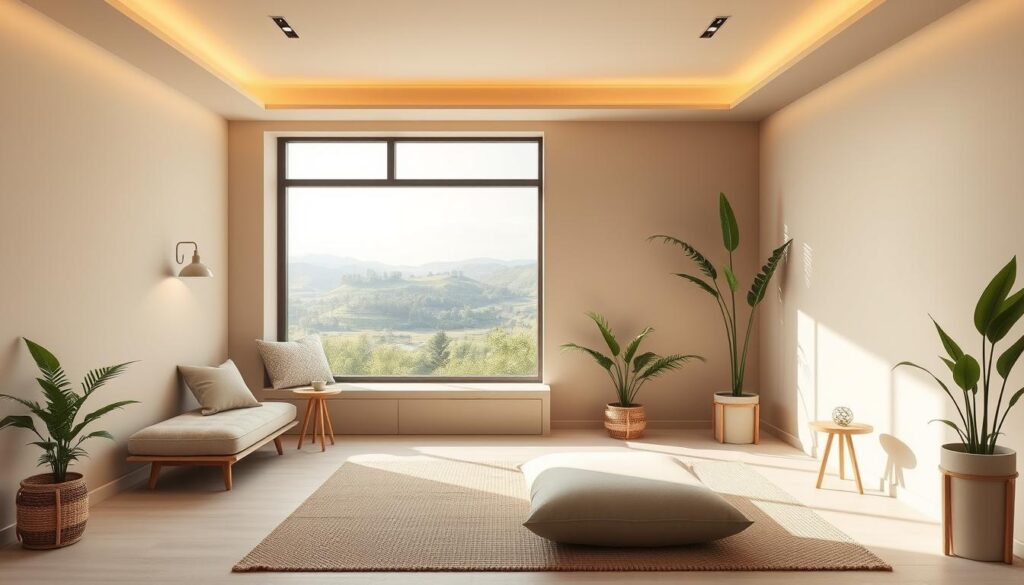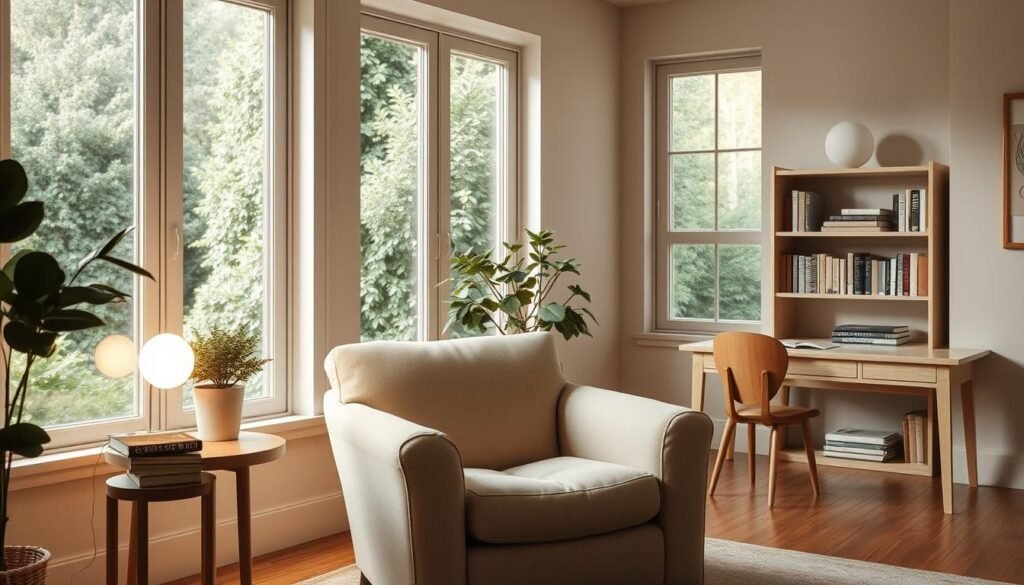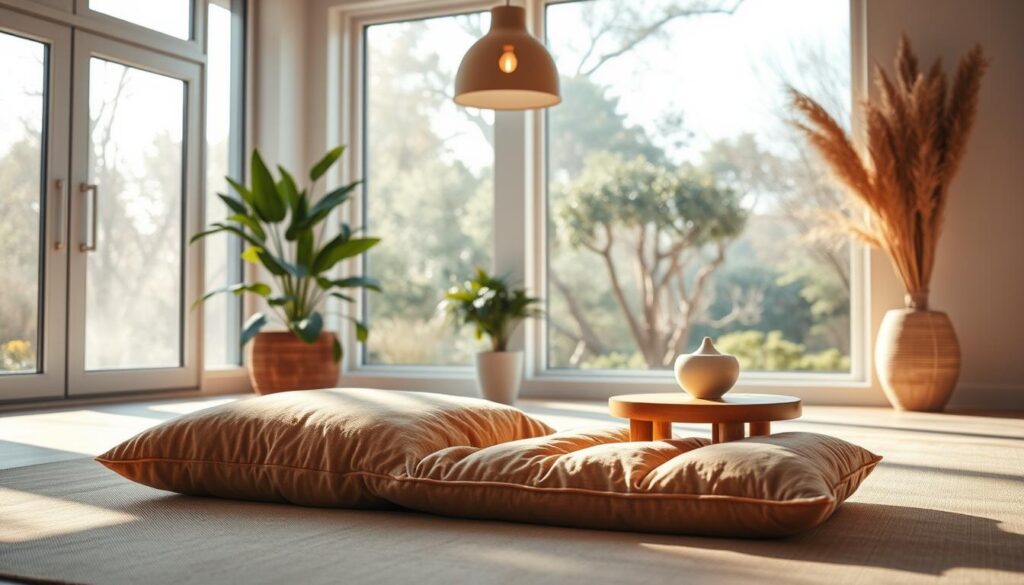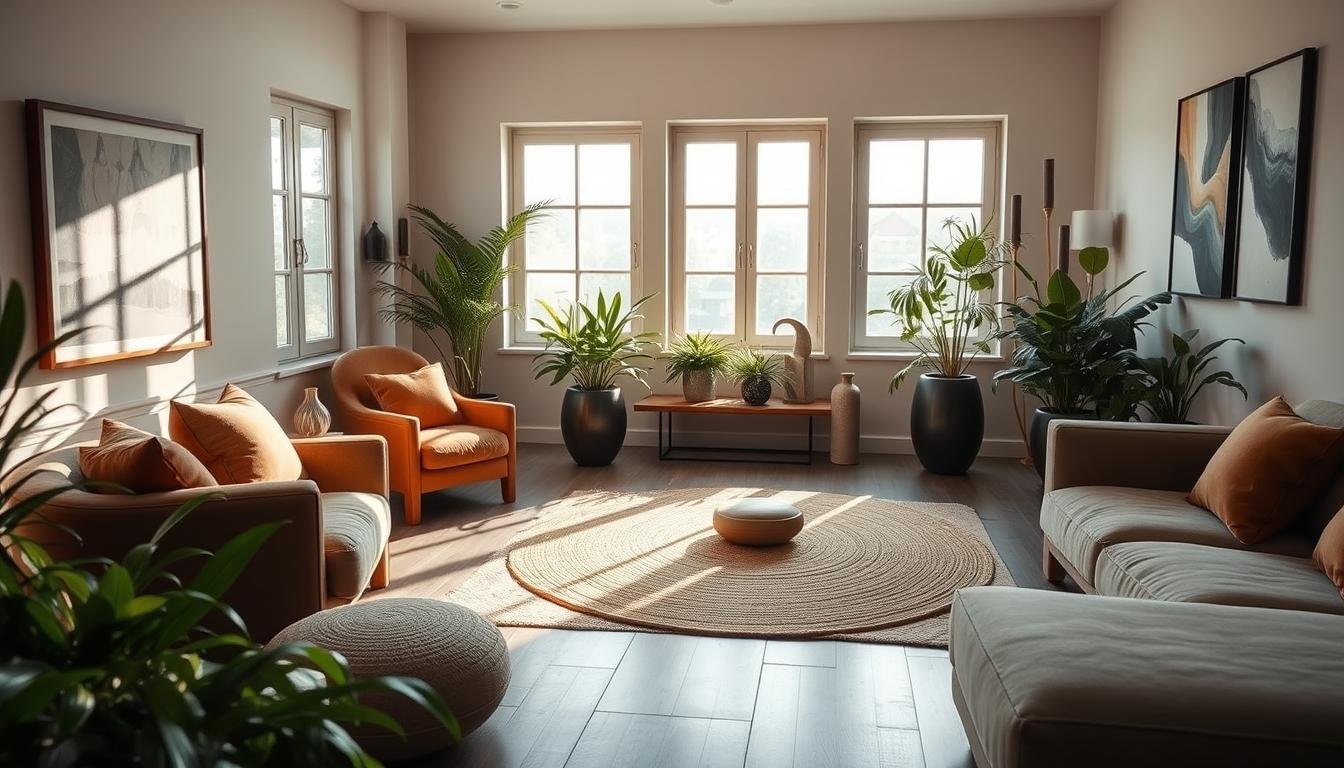Ever felt like your home is more stressful than relaxing? In today’s fast world, a personal wellness room could be the answer. It’s a way to take back your mental and physical health.
Creating a wellness room at home is now essential, not just a luxury. People are turning unused spaces into places for calm, meditation, and self-care. These rooms offer a safe space to escape daily stress and find peace.
Building a peaceful sanctuary doesn’t have to break the bank. It’s about designing with purpose, tailored to your needs. Whether you have a big house or a small one, there are ideas for creating a calm space. This space supports your well-being, no matter the size of your home.
Key Takeaways
- Wellness rooms provide a personal retreat from daily stress
- Creating a sanctuary doesn’t require extensive space or budget
- Design should focus on individual relaxation and well-being
- Wellness spaces support mental and physical health
- Personalization is key to an effective wellness room
Understanding the Wellness Room Revolution: A New Home Essential

In today’s fast world, making a personal zen space is key for well-being. At-home wellness retreat ideas are changing how we care for ourselves at home.
Modern life needs new ways to handle stress. A wellness room is a place to escape daily worries and find peace.
The Psychology Behind Personal Sanctuaries
Your home’s environment affects your mental health. Creating a calm space helps shield you from daily stress. These areas offer:
- A sense of control over your personal space
- A dedicated area for mindfulness practices
- An opportunity for emotional reset
Why Wellness Spaces Matter in Modern Living
With work-life balance getting tougher, a personal wellness area is vital. These spaces let you focus on self-care and mental health.
Benefits for Mental and Physical Health
Having a wellness room can greatly improve your health, including:
- Stress reduction
- Improved sleep quality
- Enhanced emotional regulation
- Increased overall well-being
“Your wellness space is more than a room—it’s a personal retreat designed to nurture your mind, body, and spirit.”
How to Choose the Perfect Space for Your Wellness Room

Starting a wellness sanctuary begins with picking the right spot in your home. Turn any room into a peaceful oasis by choosing wisely. Look for a place that’s quiet and away from daily noise.
When searching for the best spot, keep these points in mind:
- Natural light exposure
- Minimal external noise
- Adequate room dimensions
- Proximity to peaceful home areas
Even odd spaces can become amazing wellness spots. Self-care room ideas you’ll love can pop up in unexpected places. Think about these spots:
- Spare bedroom
- Unused corner of a living room
- Quiet basement area
- Enclosed porch or sunroom
“Your wellness space should feel like a personal sanctuary, disconnected from the chaos of daily life.” – Wellness Design Expert
To make your home a true sanctuary, set clear boundaries. Use dividers, curtains, or smart furniture to mark your wellness area. This keeps it separate from other living spaces, preserving its sacred feel.
The key is to pick a space that fits your wellness needs and brings calm and renewal.
Essential Elements of a Wellness Room Design
Creating a wellness space for mental clarity needs careful planning and thoughtful design. Your personal sanctuary should blend elements that promote relaxation and inner peace. The right design can turn an ordinary space into a powerful healing environment.

Designing your wellness room involves several critical components. These elements work together to create a truly transformative space:
Lighting Considerations for Optimal Wellness
Lighting is key in setting the mood for your wellness space. Natural light is best, but you can also create the perfect ambiance with:
- Soft, dimmable LED lights
- Himalayan salt lamps
- Adjustable light fixtures
- Indirect lighting options
Color Psychology and Material Selection
When setting up a meditation and relaxation room, color and materials are essential. Choose calming colors that promote tranquility:
- Blue: Promotes calmness and serenity
- Green: Connects with nature and healing
- Neutral tones: Creates a peaceful backdrop
Ventilation and Air Quality Features
Clean air is vital to your wellness space. Consider these air quality enhancements:
- Air purifiers with HEPA filters
- Indoor plants that naturally filter air
- Proper ventilation systems
- Natural materials that don’t off-gas toxic chemicals
Your wellness room should be a personalized sanctuary. It should meet your unique needs, helping you find mental clarity and inner peace.
Creating a Mind-Body Balance Through Thoughtful Design
Designing a wellness room is more than just decorating. It’s about making a space that helps your mind and body feel better. Your sanctuary should show your wellness journey, blending function with comfort.
When starting a DIY wellness room, keep these design tips in mind:
- Create flexible zones for different activities
- Incorporate multi-purpose furniture
- Focus on calming color palettes
- Prioritize natural lighting
Wellness room decor tips stress the need for flexibility. Your space should easily switch between meditation, yoga, stretching, and relaxing.
“Design is not just what it looks like and feels like. Design is how it works.” – Steve Jobs
To balance mind and body, add elements that engage your senses:
| Sense | Design Element |
|---|---|
| Visual | Soft, neutral colors |
| Auditory | Sound-absorbing materials |
| Tactile | Comfortable textures |
| Olfactory | Subtle natural fragrances |
Remember, your wellness room should be a personal retreat that adapts to your evolving health and relaxation needs.
Small Space Solutions: Wellness Corners for Apartments
You don’t need a big room or expensive changes to make a wellness space. Even the smallest corner in an apartment can become a place for relaxation and health. It’s your own spot where you can forget stress and focus on yourself.
Designing a relaxing space in a small apartment needs careful planning. Look for items that do more than one thing. This way, you use every inch and keep the area calm.
Maximizing Limited Space
- Choose compact, foldable yoga mats that store easily
- Invest in wall-mounted shelving for wellness equipment
- Use room dividers or decorative screens to create visual separation
- Select furniture with hidden storage capabilities
Multi-functional Furniture Ideas
Good mental health often comes from smart furniture choices. Here are some ideas:
- Ottoman with interior storage for meditation cushions
- Convertible chairs that transform into floor seating
- Lightweight, stackable meditation benches
- Collapsible side tables for aromatherapy or sound therapy tools
Space-saving Wellness Equipment
Your apartment wellness corner can have small, effective tools. They don’t have to be big to be good:
- Resistance bands instead of bulky weight equipment
- Compact meditation cushions
- Portable sound machines
- Lightweight, rollable acupressure mats
Your wellness space is a personal haven. It supports your health, no matter the size of your space.
The Rise of ‘Wellness Rooms’: Creating Your Personal Sanctuary at Home
Your home is more than just a place to live. It’s a place for your mind and body to heal. The idea of a wellness-focused interior design has changed how we see our homes. Now, a home wellness sanctuary for stress relief is essential in our busy lives.
Having a wellness room in your home is more than just a trend. It’s a vital space for escaping daily stress. It’s a place for you to relax and take care of yourself. Today, people are making spaces in their homes that help them feel whole.
- Reduces daily stress and anxiety
- Promotes mental health and mindfulness
- Creates a dedicated space for personal restoration
- Enhances overall home environment
When designing your wellness room, focus on calm and comfort. Turn a spare room, corner, or even a large closet into your own retreat. The aim is to make a space that meets your unique needs for relaxation.
| Space Type | Size Requirements | Recommended Features |
|---|---|---|
| Small Corner | 3-5 sq ft | Meditation cushion, small plant, soft lighting |
| Dedicated Room | 80-120 sq ft | Yoga mat, sound system, comfortable seating |
Your wellness room is an investment in your health. Start small and be thoughtful. Create a space that truly supports your well-being journey.
Incorporating Natural Elements for a Calming Atmosphere
To make your home a spa, add natural elements. This turns your wellness room into a peaceful place. The link between your home and mind is strong. So, using biophilic design is key for a calm space.
Start by seeing how nature affects you. Natural elements make your space calm and reduce stress. This helps you relax.
Biophilic Design Principles
Biophilic design connects your home with nature. It includes:
- Maximizing natural light exposure
- Incorporating organic textures and materials
- Creating visual connections with nature
- Using natural color palettes
Indoor Plants for Wellness
Indoor plants do more than look good. They clean the air and make your space calm. Here are some easy-to-care-for plants:
- Snake Plant: Excellent air purifier
- Peace Lily: Reduces indoor air pollutants
- Aloe Vera: Promotes healing and clean air
- Spider Plant: Removes toxins effectively
Adding these natural elements makes a peaceful wellness space. It cares for your body and mind.
Technology Integration in Modern Wellness Spaces
The future of wellness spaces at home is changing fast. Smart technology is making it easier to create a wellness room. Now, you can relax and take care of yourself in new ways.
Smart devices are changing what a wellness room can be. Imagine a space that changes to fit your mood and needs:
- Intelligent lighting systems that mimic natural daylight cycles
- Sound machines with personalized meditation tracks
- Air purifiers with real-time air quality monitoring
- Biometric tracking devices for stress management
Virtual reality experiences are pushing the boundaries of wellness technology. You can now explore peaceful places – from beaches to mountains – right from home.
“Technology should enhance our wellness, not distract from it.” – Wellness Design Expert
When adding technology to your wellness space, choose wisely. Pick devices that really help your mind and body. This way, you create a space that truly helps you relax and be mindful.
Think about design, noise, and how well it fits in. Your wellness room should be calm and peaceful, not cluttered or noisy.
Essential Equipment and Accessories for Your Wellness Room
To make a home sanctuary for relaxation, you need the right equipment. It turns your space into a personal wellness retreat. The right accessories make your wellness room a true sanctuary of peace and rejuvenation.
Designing your wellness room is more than just looks. It’s about choosing tools that help your mind and body.
Meditation and Yoga Essentials
Your wellness room needs basic items for mindfulness and physical practice:
- High-quality yoga mat with extra cushioning
- Meditation cushions or zafu pillows
- Yoga blocks for proper alignment
- Comfortable, breathable workout clothing
- Soft, supportive bolsters for restorative poses
Aromatherapy and Sound Therapy Tools
Add sensory wellness tools to your home sanctuary for a holistic relaxation environment:
| Tool | Purpose | Recommended Brands |
|---|---|---|
| Essential Oil Diffuser | Mood enhancement and air purification | doTERRA, Young Living |
| Himalayan Salt Lamp | Natural air purification and calming ambiance | Levoit, Crystal Allies |
| Tibetan Singing Bowl | Sound therapy and meditation | Silent Mind, DharmaObjects |
Creating your own wellness retreat at home is about making a space that fits you. Each accessory should help your mental and physical health. This turns an ordinary room into a sanctuary of tranquility.
Maintaining Your Wellness Space: Daily Practices and Rituals
Creating a personal sanctuary at home is more than just design. It needs daily care and mindful practices. Daily rituals can turn your wellness room into a powerful tool for mind and body renewal.
Begin with a consistent cleaning routine to keep your wellness room inviting. Many wellness room designs forget the importance of a clutter-free space. Spend 5-10 minutes each day to organize and refresh it, making it a calming retreat.
- Dust surfaces and clean meditation cushions weekly
- Rotate essential oils and refresh aromatherapy tools
- Wipe down yoga mats and fitness equipment
- Water and care for indoor plants
Wellness trends show the power of routine. Develop a morning or evening ritual for your wellness space. This could include:
- 5-minute morning meditation
- Evening breathing exercises
- Journaling or reflection time
- Gentle stretching or yoga practice
Your wellness room should change with your needs. Flexibility is key to creating a stress-free space at home. Let the room serve multiple purposes while keeping its core purpose of relaxation and self-care.
“A well-maintained wellness space is a sanctuary for both body and mind.” – Wellness Design Expert
Budget-Friendly Ways to Create Your Wellness Sanctuary
Creating a calming room doesn’t need to cost a lot. The ultimate guide to home wellness spaces shows that smart design is more important than pricey gadgets. You can make a peaceful space with a little creativity and not much money.
Wellness rooms 2025 trends highlight the importance of making it your own. You can turn any area into a serene spot without spending a lot.
- Repurpose existing furniture for multipurpose functionality
- Use paint to create calming color schemes
- Incorporate natural elements from your garden or local park
- DIY meditation cushions and decor
There are many ways to save money:
| Area | Low-Cost Solution | Estimated Cost |
|---|---|---|
| Lighting | LED candles, string lights | $20-$50 |
| Flooring | Yoga mat, secondhand rug | $30-$75 |
| Decor | Thrift store finds, plants | $50-$100 |
Pro tip: Your intention and personal energy matter more than expensive equipment. Focus on making a space that feels genuinely peaceful to you.
Wellness is not about perfection, but about creating a space that nurtures your mind and body.
Your wellness sanctuary shows your inner peace. Start small, be creative, and watch your personal retreat come to life without spending a lot.
Conclusion
Creating a wellness room is more than just design. It’s about making a personal space that helps your mental health. Your home can be a place for stress relief and self-care, no matter the size.
Understanding your needs is key to a great wellness room. You don’t need fancy stuff or a lot of space. What matters most is your intention, creativity, and care for yourself. Simple things like natural light and calming colors can make a big difference.
Your wellness journey is unique and keeps changing. Start small and be kind to yourself. Let your space grow with your wellness goals. Every choice, from a meditation cushion to a plant, helps in healing.
Design a space that shows who you are and cares for your spirit. A wellness room is a powerful way to show self-love and growth. Your sanctuary is waiting to support you through life’s ups and downs.





